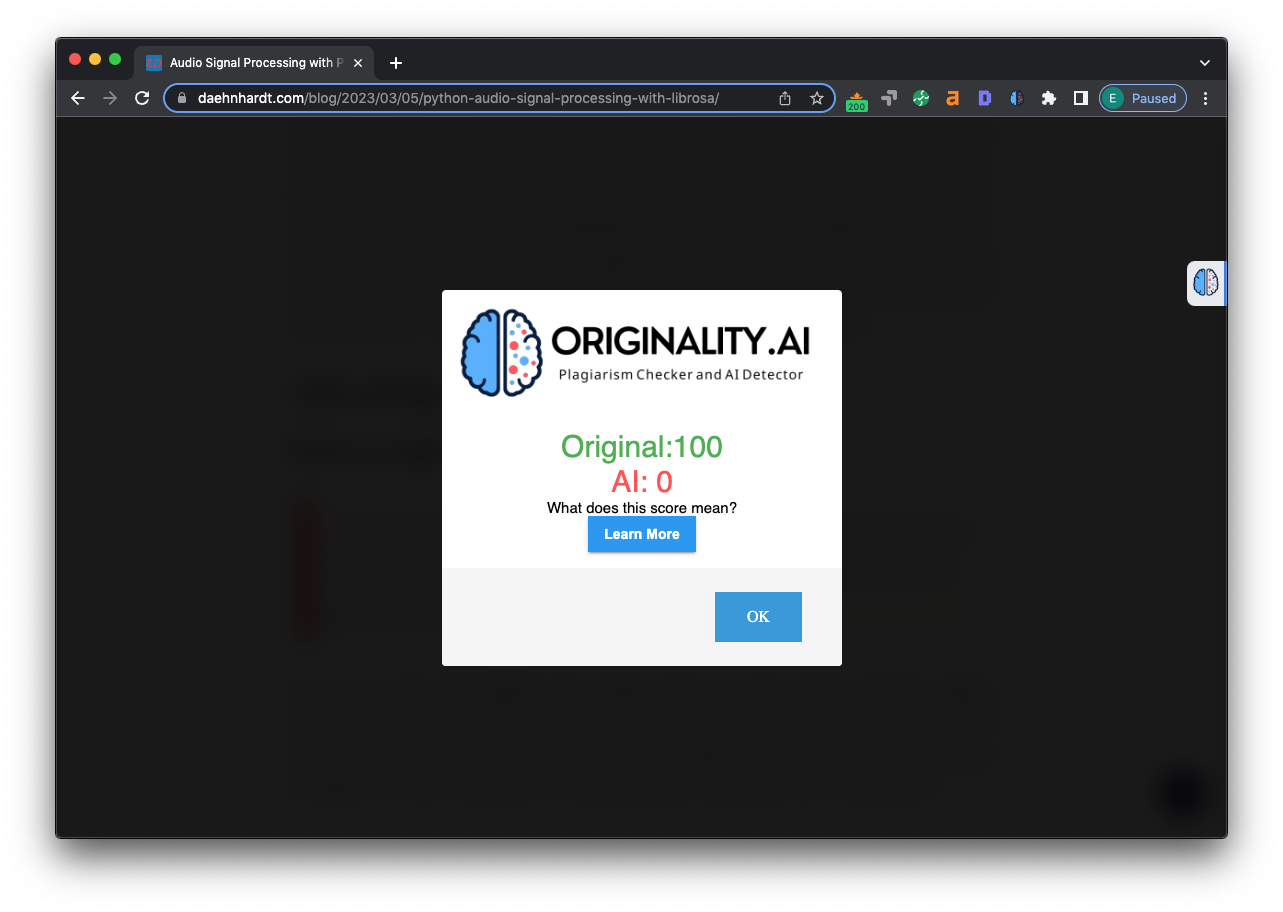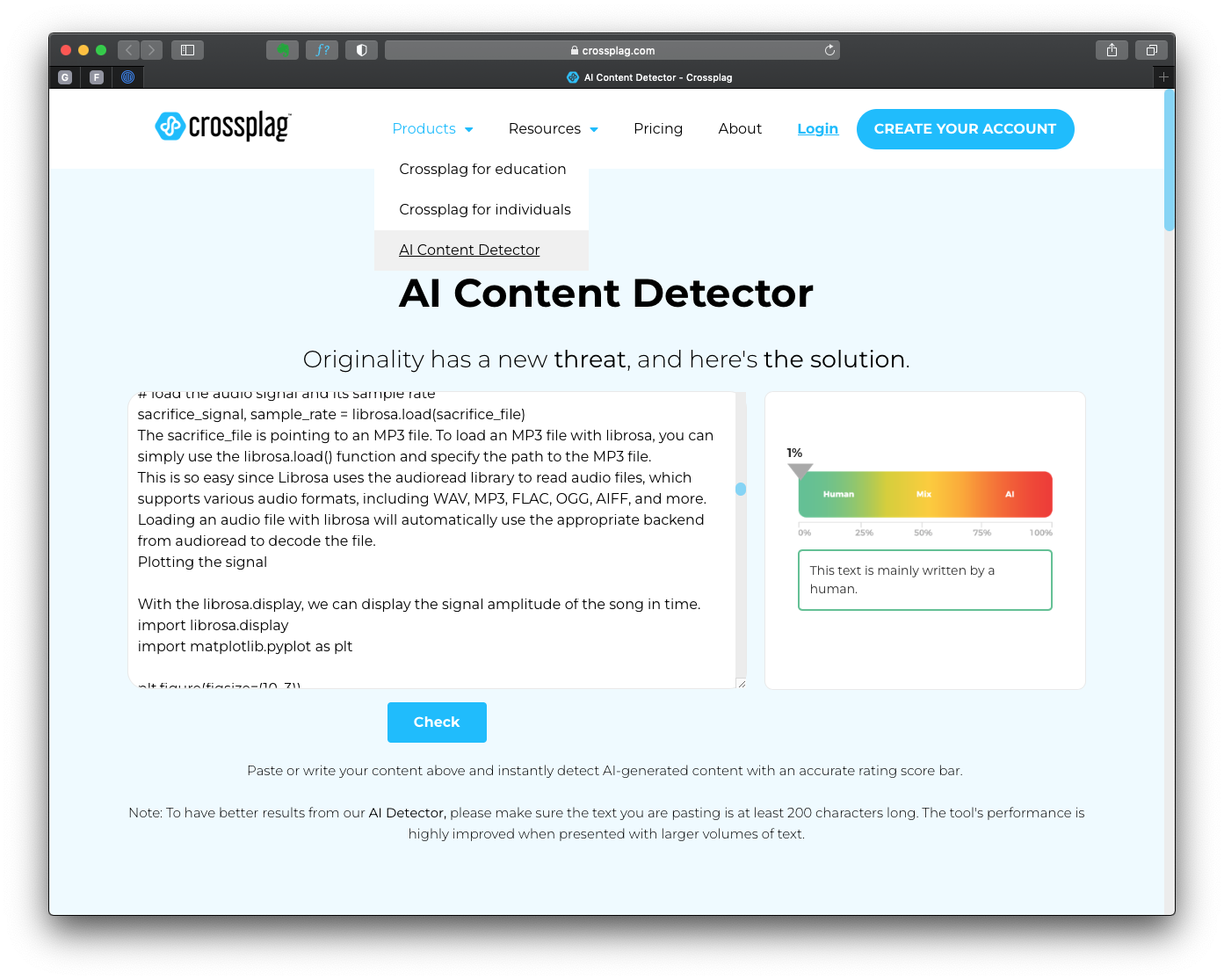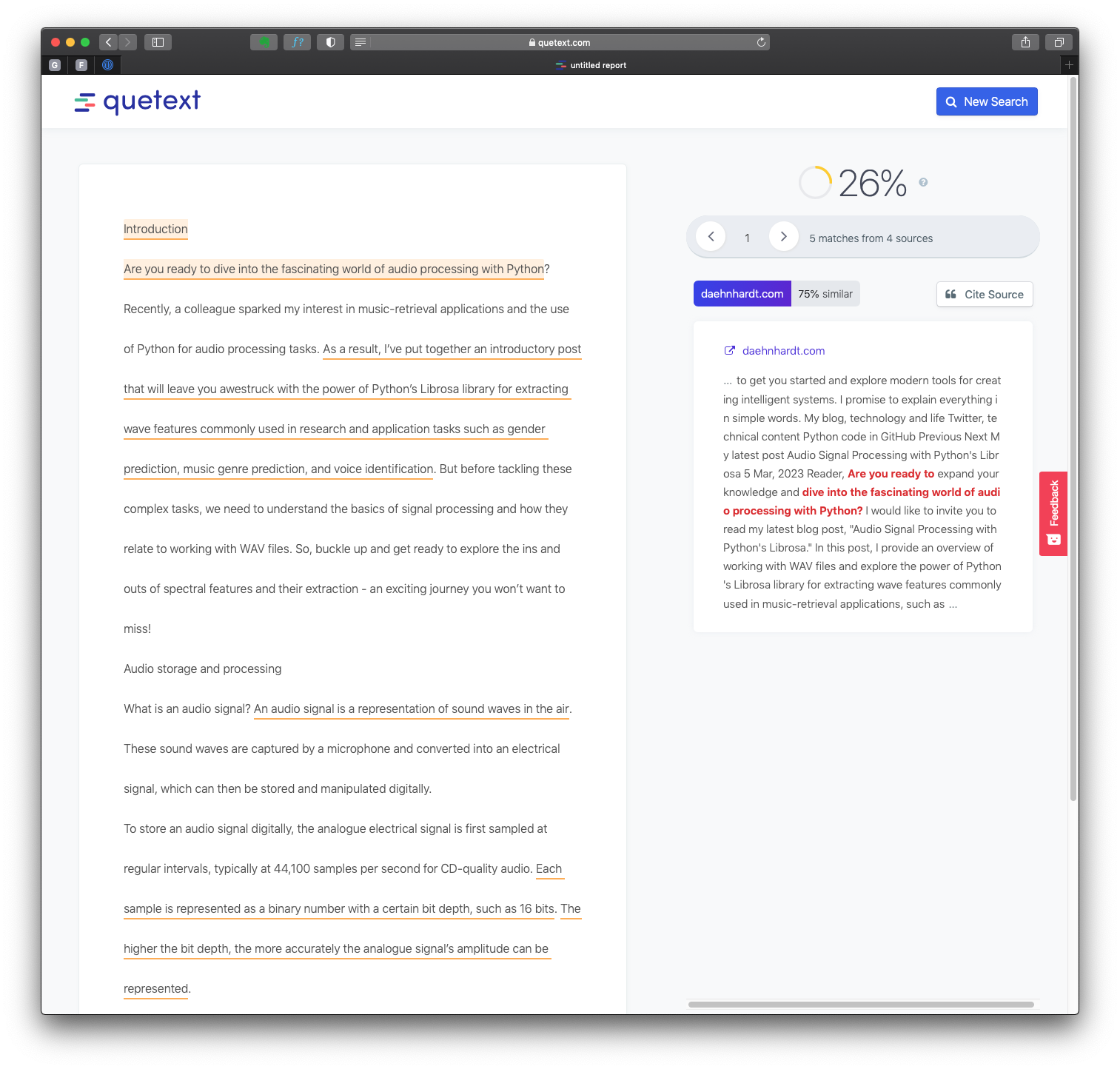Introduction
With the development of AI-content generators such as chatGPT, we have a new need to identify such content, and the tools of AI-content detection are currently being developed. Writing assistants and plagiarism detection tools also include AI-content detection. In this post, I talk about the most visible AI tools that help us mitigate plagiarism and motivate us to create original and well-written content. Indeed, I will start with the definition of plagiarism, why it’s terrible, and move quickly into helpful tools in AI-content and plagiarism detection that are available today.
What is plagiarism?
Plagiarism is using someone else’s work or ideas without giving them proper credit or attribution. It is considered a form of academic dishonesty. It can result in severe consequences, including loss of reputation, academic sanctions, and legal action.
Plagiarism becomes even more apparent in the time of AI-generated content such as created with chatGPT. For creating good quality content, we want to avoid plagiarism while creating original content, which is helpful for our readers. Sadly, chatGPT does not cite its sources or give a reference list. That would be a helpful feature! Luckily, we have many AI tools that help us detect plagiarism, some of which also see AI-generated content!
In this post, I will reiterate why avoiding plagiarism is fantastic for all of us! I will give you a practical list of helpful plagiarism detection tools, including Originality.AI, which also detects GPT-generated content. I am affiliated with Originality.AI since it’s a great tool, and I have to support my blog, which is free for everyone to enjoy reading.
Why is it harmful to society?
Plagiarism is harmful to society for several reasons. First, it undermines the principles of originality and creativity essential to intellectual and artistic pursuits. By copying or using someone else’s work without permission or attribution, individuals fail to contribute their unique ideas and insights to the conversation.
Second, plagiarism is unfair to the original creators of the work, who have put in the time, effort, and creativity to produce something of value. When others take credit for their work, it diminishes their achievements and can be demotivating.
Third, plagiarism can have severe consequences for academic and professional institutions. It can compromise research integrity, damage reputation, and erode trust in academic and professional communities.
Finally, plagiarism can lead to losing trust and respect in relationships. When individuals plagiarise, they lie and mislead others about their abilities and accomplishments, leading to a breakdown in trust and damaging relationships.
Plagiarism harms society by undermining the values of creativity, originality, and integrity essential to personal and professional growth and success. It is important to always give proper credit and attribution when using the work of others and to strive to contribute our unique ideas and insights to the conversation.
In some cultures, plagiarism is seen as a noteworthy complement to the original author. However, I still recommend citing the prior work for the reasons above and academic integrity.
Academic integrity
What is academic integrity? Why is it important to cite?
Academic integrity refers to the principles and values that guide ethical behaviour in educational settings. It includes honesty, fairness, and respect for other’s ideas and work. Academic integrity is essential because it promotes trust, respect, and justice in academic communities and helps to ensure that academic work is credible, accurate, and reliable.
Citing sources is an essential aspect of academic integrity because it demonstrates respect for the work of others and helps to ensure the accuracy and reliability of academic research. Citing sources allows readers to trace the origins of ideas and information presented and gives credit to the original authors and researchers who contributed to the field. By citing sources, you also demonstrate that you have conducted thorough research and are building upon the work of others respectfully and ethically.
Also, proper citation is necessary to avoid plagiarism, which violates academic integrity. Plagiarism undermines the principles of originality and creativity essential to scholarly pursuits and can lead to severe consequences, including loss of reputation, academic sanctions, and legal action.
Academic integrity is essential for promoting trust, respect, and fairness in academic communities. Citing sources is an essential aspect of academic integrity because it demonstrates respect for the work of others and helps to ensure the accuracy and reliability of academic research.
The best practice
Following best practices for citing and referencing sources in your work is important to avoid plagiarism. Here are some tips to help you avoid plagiarism:
-
Ensure you understand what plagiarism is and how to avoid it. Familiarize yourself with your institution’s guidelines on academic integrity and plagiarism. Usually, good universities provide students with an introduction to intellectual honesty, anti-plagiarism practices, and proper citation guidelines. That usually happens in the first year of study.
-
When writing about a topic, use your own words and ideas to explain the concepts. If you need to include a direct quote, use quotation marks and cite the source appropriately. You must improve your literacy skills and learn about alternative works, synonyms, and the correct terminology in your research area. I recommend reading a lot and using a thesaurus. Thesauruses can be found in print or online and are often used by writers, students, and language learners to expand their vocabulary and improve their writing skills.
-
Keep a record of the sources you use, including the author, title, publication date, and page numbers. This will make it easier to create accurate citations and references later.
I have used Zotero for managing my citations. Zotero is a free and open-source citation management tool that allows users to easily collect, organize, and cite sources from the web, library databases, and other sources and integrates with popular word processing software.
Another tool, EndNote, is a comprehensive citation management tool that offers advanced features such as automatic citation formatting, sharing of references, and access to thousands of citation styles. It is available as both a desktop and web-based application.
-
Use the appropriate citation style for your disciplines, such as MLA or Chicago. Ensure to follow the formatting guidelines, in-text citations, and reference lists. Your tutor usually asks you to format your bibliography or references list using a specific citation style.
-
If you need to paraphrase someone else’s work, do so. Use your own words to restate the ideas, but be sure to still credit the original source. Acknowledging other ideas shared in discussion or chat is very important. For instance, if your colleague or fellow student gives your thoughts, don’t hesitate to accept the input of others and provide credit for intelligent people helping you to succeed. That’s friendly and honourable.
-
Use plagiarism detection software or tools to check your work for potential plagiarism. This will help you catch any accidental plagiarism and ensure you give proper credit to all sources. We sometimes do multiple proofreads to capture missed references and typing errors.
-
Acknowledge AI-content generation tools you use if it’s acceptable in your school or organisation. Ask your supervisor before using AI tools for content generation.
-
If you need help with how to properly cite a source or need help avoiding plagiarism, reach out to a librarian, writing centre, or other academic resources for assistance. Your tutor would also be happy to help.
Do you have to cite your work when using your previous material? Yes, paraphrase it and add a proper citation :)
By following these best practices, you can ensure that your work is original, accurate, and properly cited and avoid any potential issues with plagiarism.
AI-content and Plagiarism detection
Herein I write about plagiarism detection software that I find helpful and recommend to any writer in the academy or industry. We want to acknowledge the hard work of others, and we will get cited in return when producing good quality content which is informative and well-cited. That’s how it works, guys, and it is wise to be polite and friendly.
I like papers with many references, meaning people read the background literature and consider how to build on it. Also, we want to improve our work, and it’s how we progress.
In this section, I will briefly summarise tools that can detect duplicate and AI-generated content:
-
Originality.AI: detects AI and plagiarism
-
AI content detector: human or AI?
-
Grammarly: grammar, plagiarism and AI-content detection
-
Copyscape: searches web for duplicate content
-
Quetext: checks for plagiarism
-
Turnitin’s suite of grading and feedback tools: focuses on plagiarism detection and grading for education
-
PlagScan: plagiarism detection software, where is the free demo?
-
Plagiarismcheck: plagiarism detection, checks only one page using the free version
-
https://www.duplichecker.com: plagiarism check up to 1000 words with their web tool
I have mixed both types of tools since all plagiarism checkers will likely include an AI-detection feature soon to keep up with the competition and demand.
Interested? Keep reading or check these links yourself. The feature set of these tools could be changed since this blog post was created.
Originality.ai
Originality.AI is a very new and quite advanced tool helping to identify GPT-3 content and duplicate content. Originality.AI is designed to help educators and students detect plagiarism in written work by comparing it to an extensive database of sources, including academic journals, books, and online content. The software uses advanced algorithms to analyze the text and identify potential matches or similarities with other sources. That’s an area of building language models, which is machine learning and related to Natural Language Processing, and I have some blog posts about it.
I have used the Originality.AIto check my latest blog post. It confirmed that the post is 100% original and does not contain AI-generated content. I am relieved!
Originality.AI app checks for plagiarism and AI content
In addition to identifying potential instances of plagiarism, Originality.AI also provides users with detailed reports that highlight specific areas of concern and suggest ways to improve the originality of their work.

Originality.AI Plugin Checks for AI content on a web page
Originality.AI has also a browser plugin for Chrome for detecting AI content, and a website checker tool. However, you should be cautious when starting it since you might need more credits when checking large websites.
Writer’s AI Content Detector
There is another online tool that can detect GPT-generated content. You can paste your text or provide an URL. I am glad that their AI content detector thinks that my content is 100% human :)

AI content detector at writer.com
Grammarly Plagiarism Checker
Grammarly is a popular online writing assistant with a plagiarism checker tool. Grammarly scans your text against over 16 billion web pages to identify potential instances of plagiarism. It is free, but the premium version offers more advanced features.
If you are interested, I have written about Grammarly and fellow tools in one of my previous posts “Say Goodbye to Grammar Gaffes with Grammarly! with this screenshot below.

Grammarly plagiarism check
Crossplag
Crossplag AI Content Detector supports more than 100 languages and has a free version to check up to 1000 words. It also has ai-content-detector online Luckily, Crossplag thinks that my blog post on signal processing is 99% human :)

Crossplag AI Content Detector online
Copyscape
Copyscape is a well-known plagiarism detection tool that searches the web for duplicate content. It is used by website owners, bloggers, and content creators to protect their content from theft. Copyscape offers both free and paid plans.
Quetext
Quetext is a free online plagiarism detection tool that checks your text against billions of sources to identify potential matches. It also provides a detailed report highlighting any areas of concern. You can paste your text into a text field, get information on duplicate content while providing citations, and generate the source in MLA, APA, and Chicago formats.

Quetext plagiarism checker
Turnitin
Turnitin is a leading plagiarism detection software widely used by educational institutions. It compares student work to a vast database of sources to identify potential instances of plagiarism. Turnitin is available to educators on a subscription basis. Usually, Turnitin is available via university access. It has a comprehensive set of draft assessment, similarity and originality checkers. See Turnitin’s suite of grading and feedback tools
Fortunately, you can use the Turnitin-based free tool at https://www.scribbr.com/plagiarism-checker/, wherein you can upload your document via the web interface.
PlagScan
PlagScan is a plagiarism detection software that checks your text against millions of sources to identify potential matches. It is used by educational institutions, publishers, and businesses to protect their content. I could not find a free version of PlagScan, so please let me know if you used it.
PlagiarismCheck.org
This free online plagiarism detection tool checks your text against multiple sources to identify potential instances of plagiarism. It also provides a percentage score indicating your text’s originality level. You can check only one page using the free version at https://plagiarismcheck.org.
DupliChecker
DupliChecker is a free online plagiarism detection tool that checks your text against multiple sources to identify potential matches. It also provides a detailed report highlighting any areas of concern. You can check up to 1000 words with their web tool at https://www.duplichecker.com. I was pleased that the DupliChecker found my website with the content I have provided :)
Conclusion
In this post, I have provided a list of plagiarism detection tools. You can choose a plagiarism checker that you like. Just remember to cite correctly and follow your institution’s guidelines. And you are okay with your academic integrity and future success in the academy. It’s good to remember that these tools are becoming more advanced with AI, including new features such as AI-content detection, and that’s great and very useful!
Did you like this post? Please let me know if you have any comments or suggestions.
Posts about AI Apps that might be interesting for youReferences
1. Say Goodbye to Grammar Gaffes with Grammarly!
3. AI Content Detector Chat GPT - Originality.AI
6. Crossplag AI Content Detector
9. Turnitin’s suite of grading and feedback tools
11. https://www.scribbr.com/plagiarism-checker/
12. https://plagiarismcheck.org

